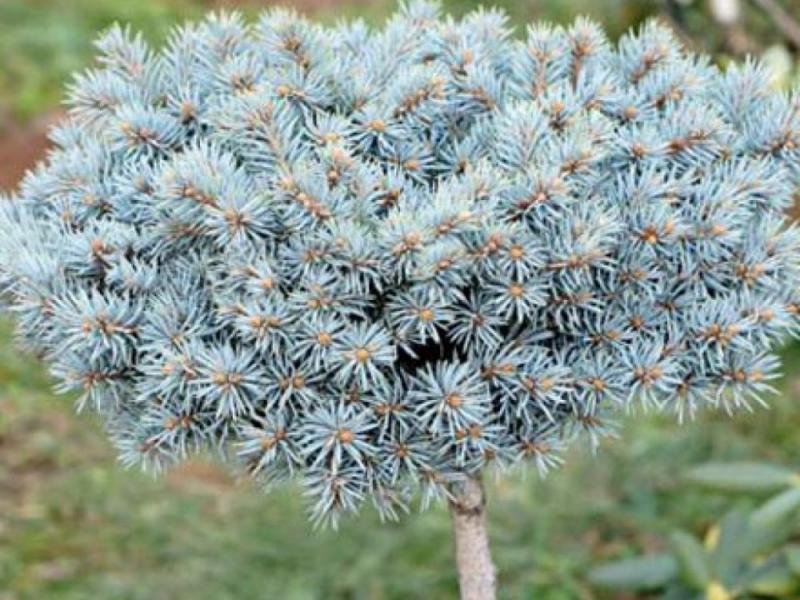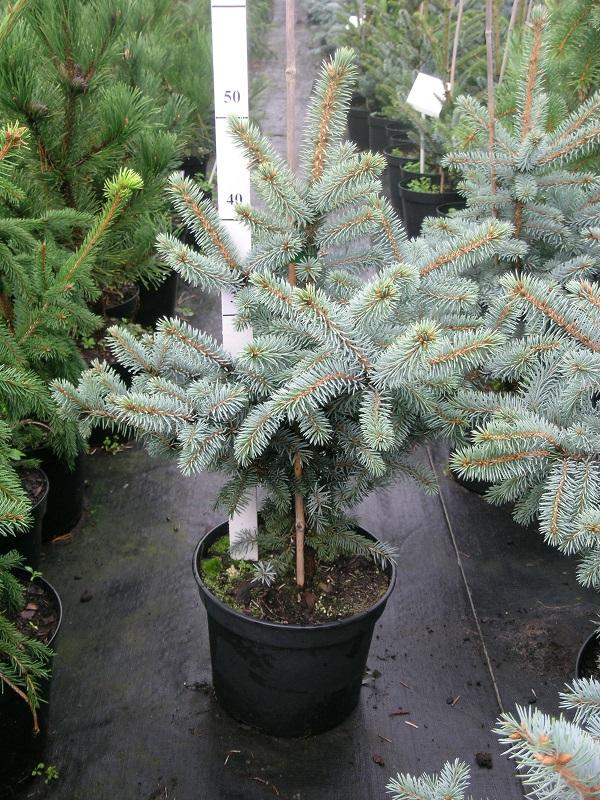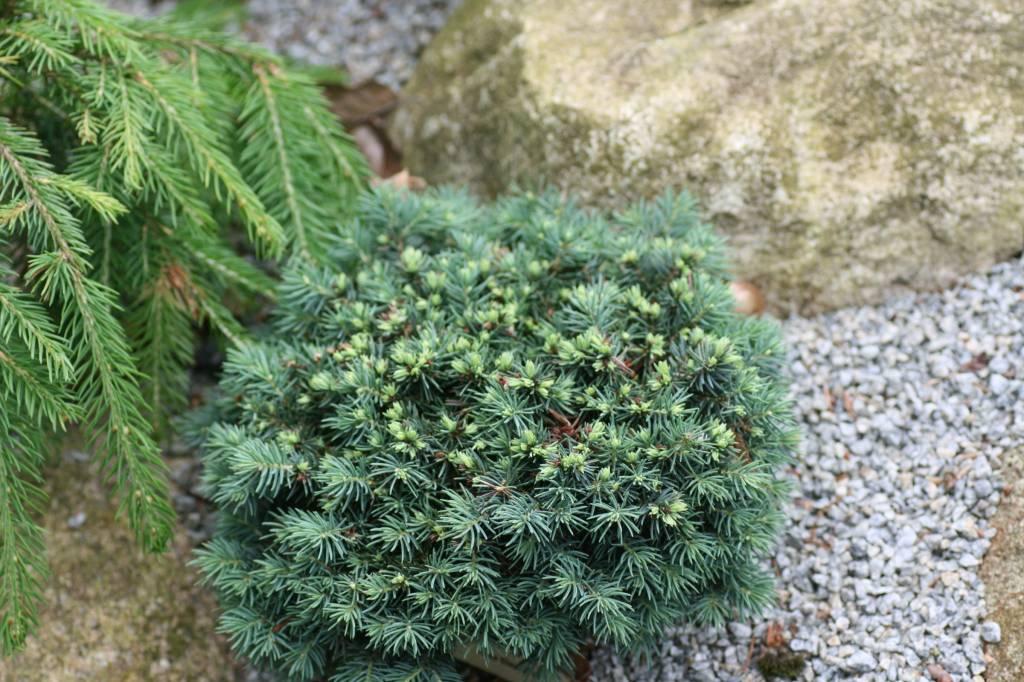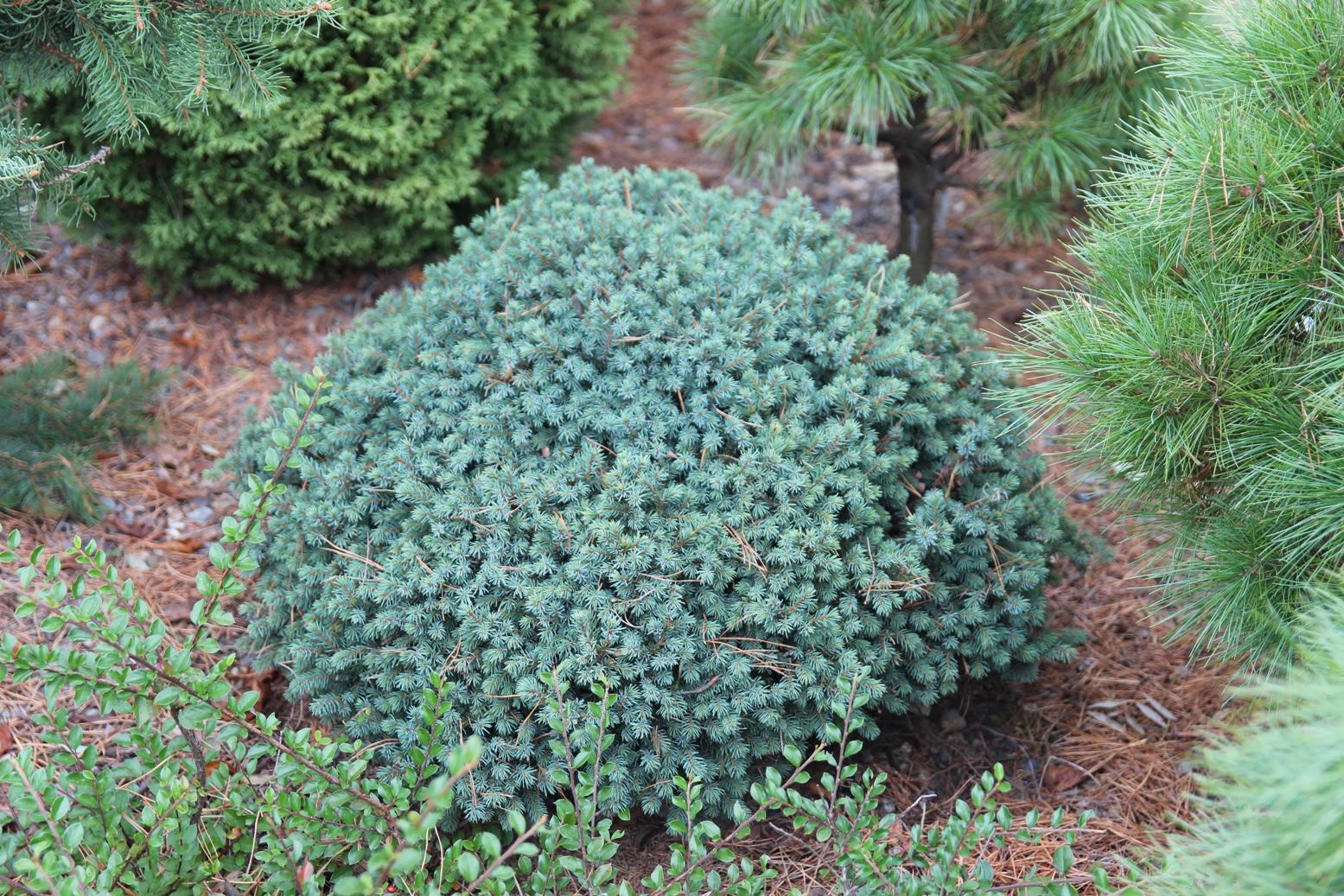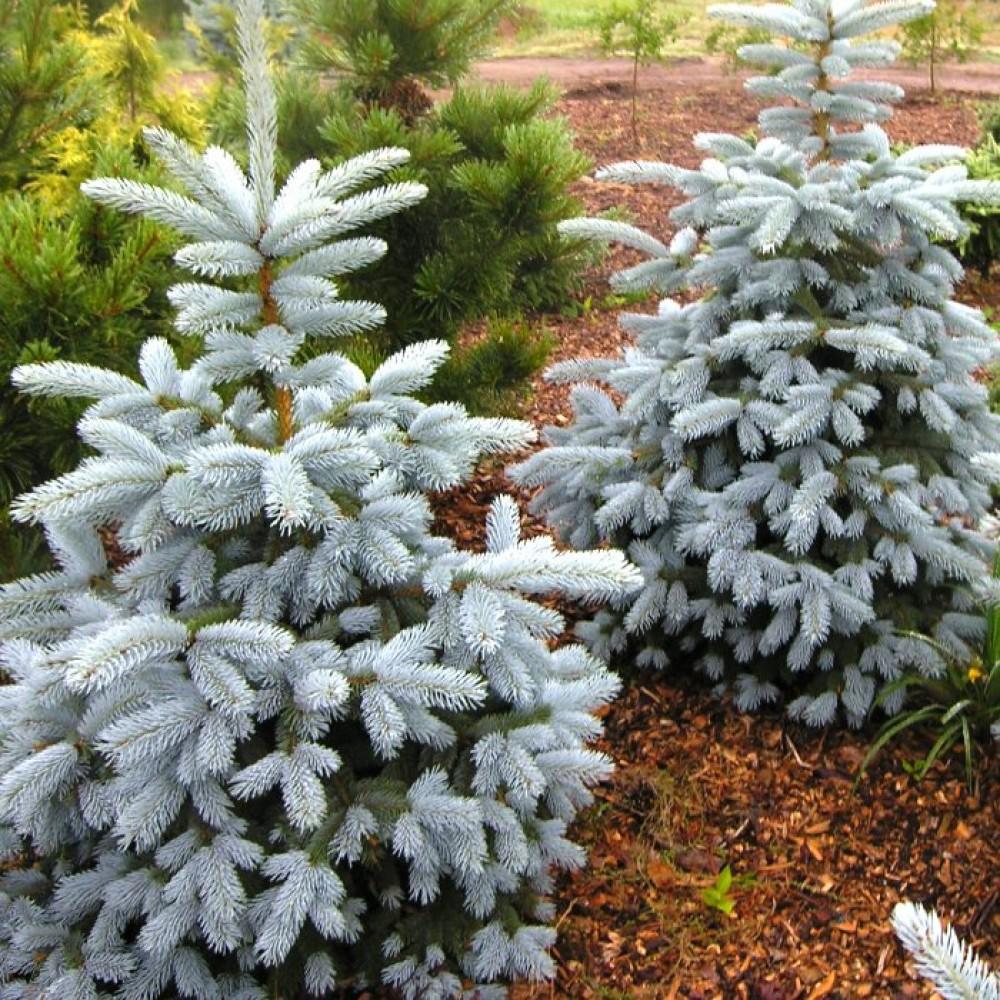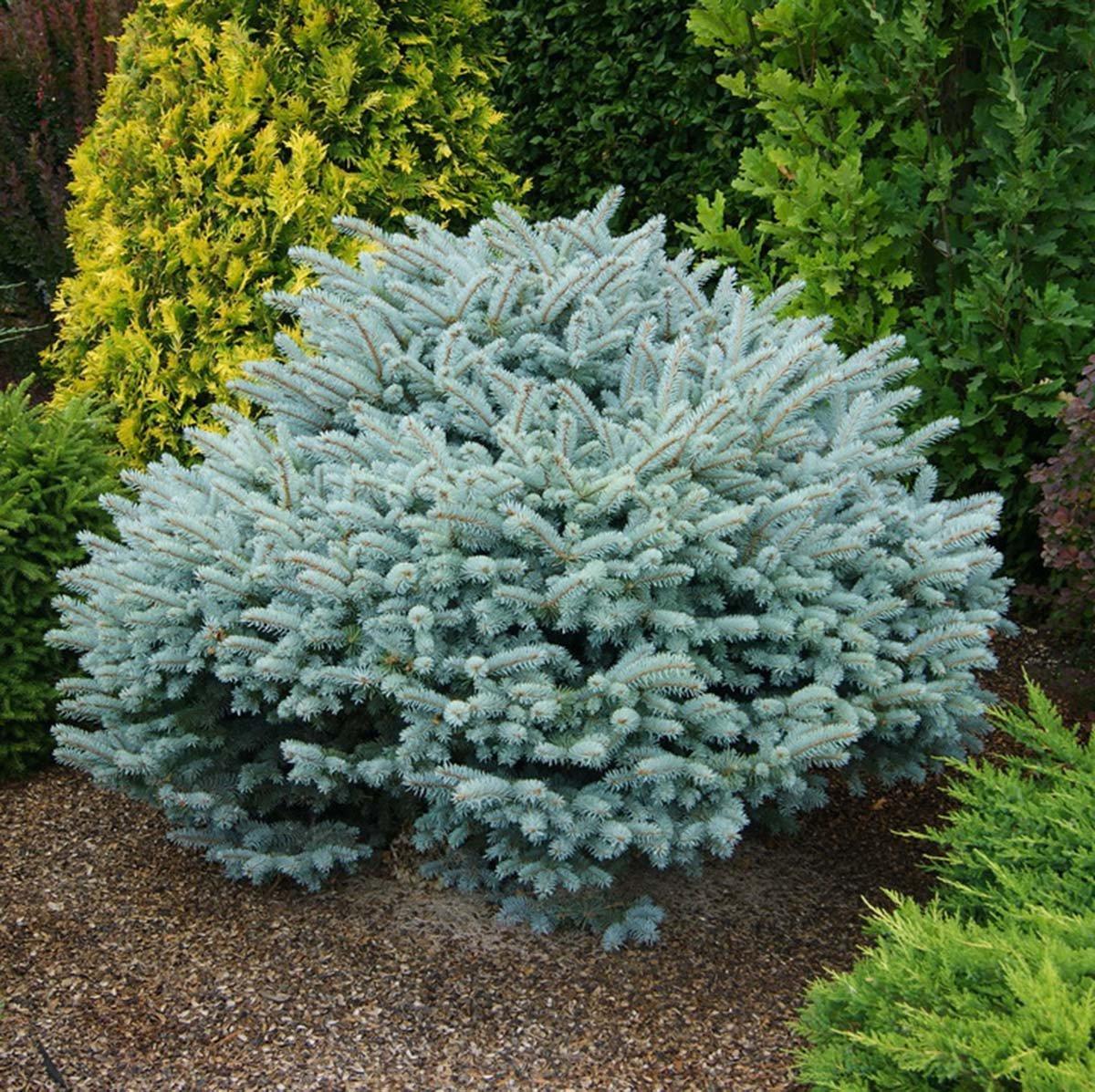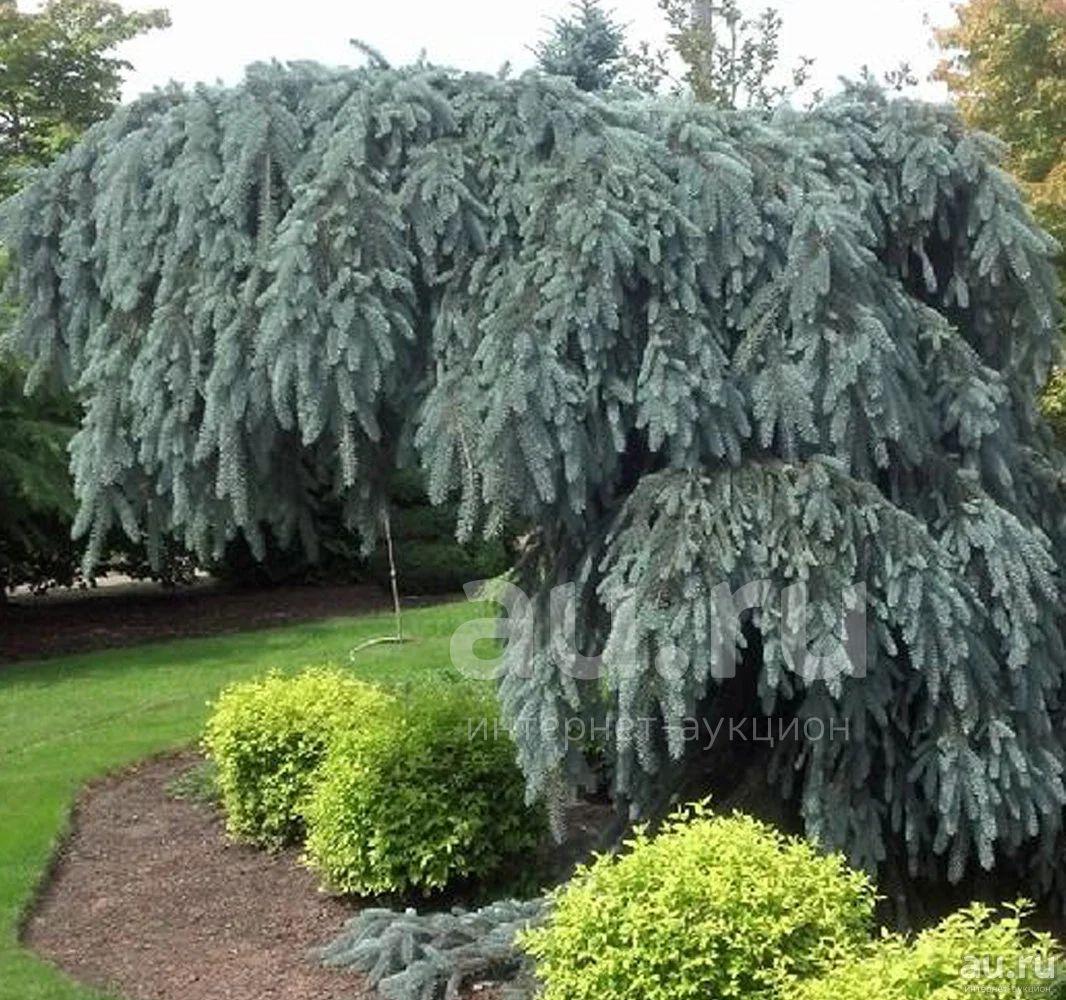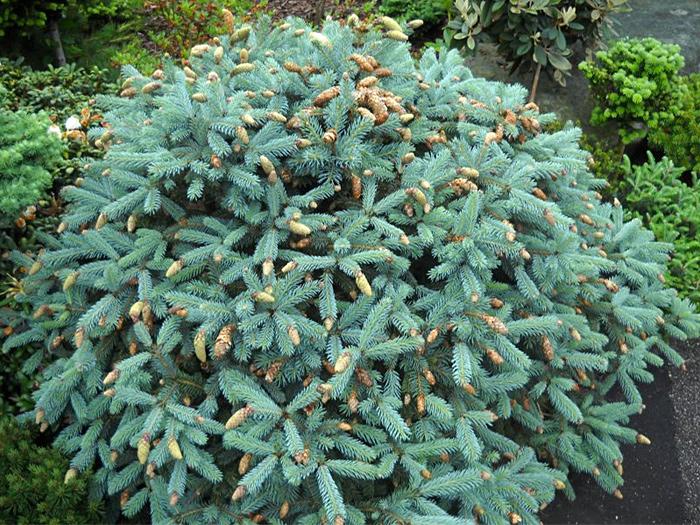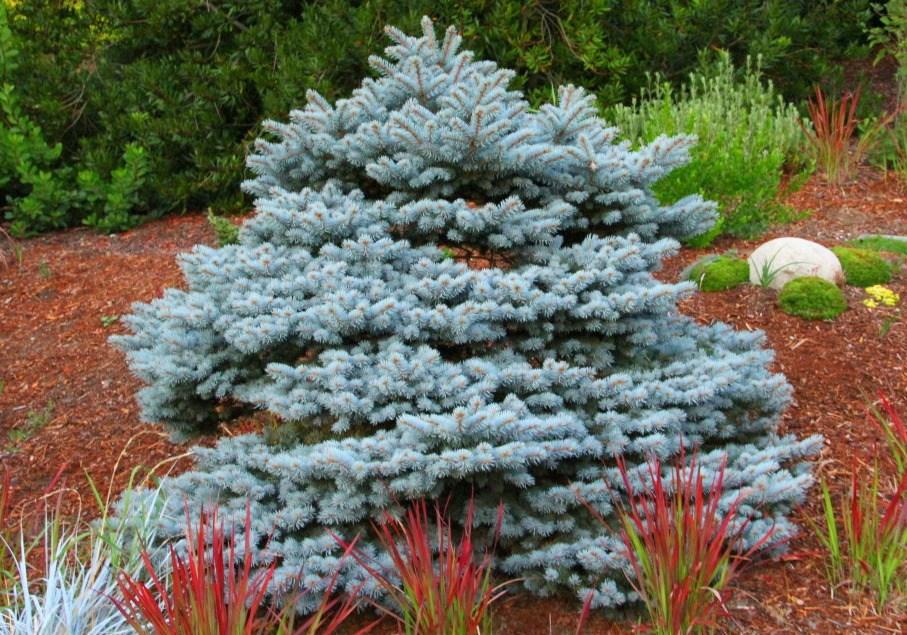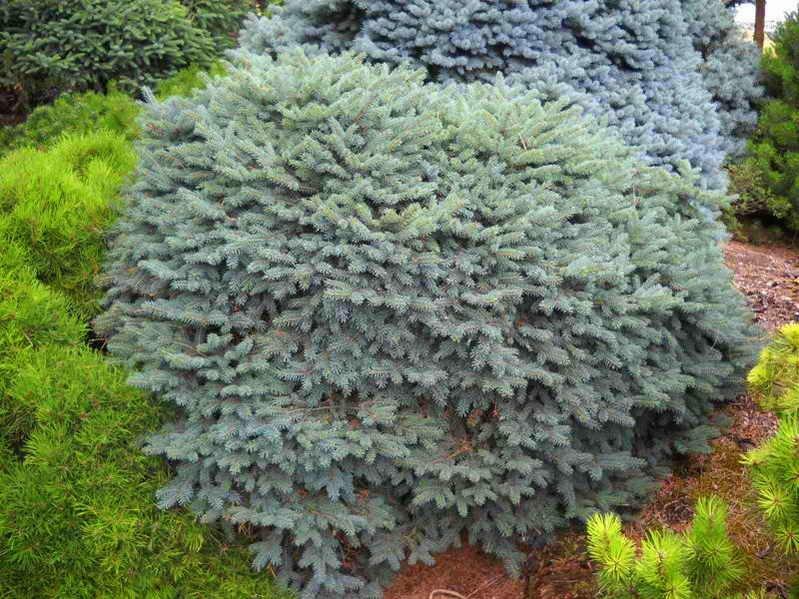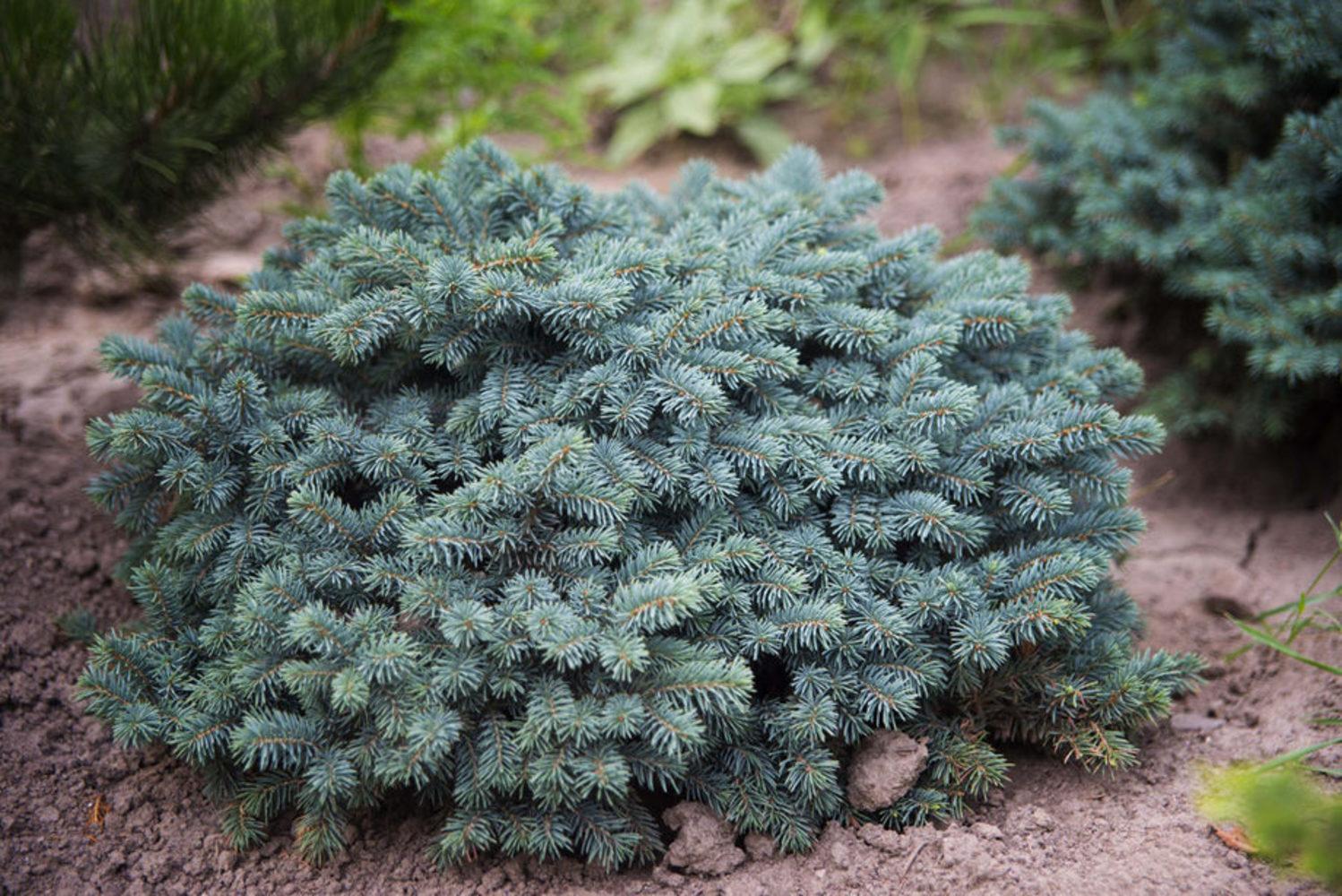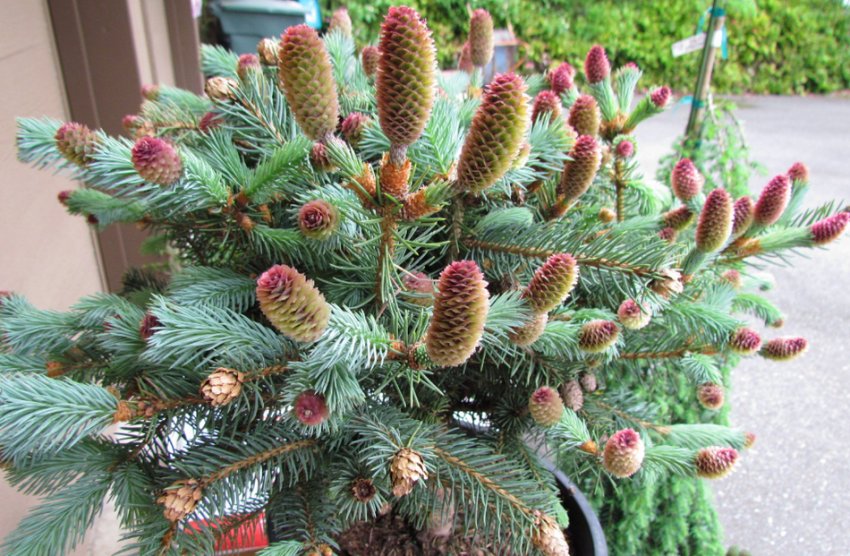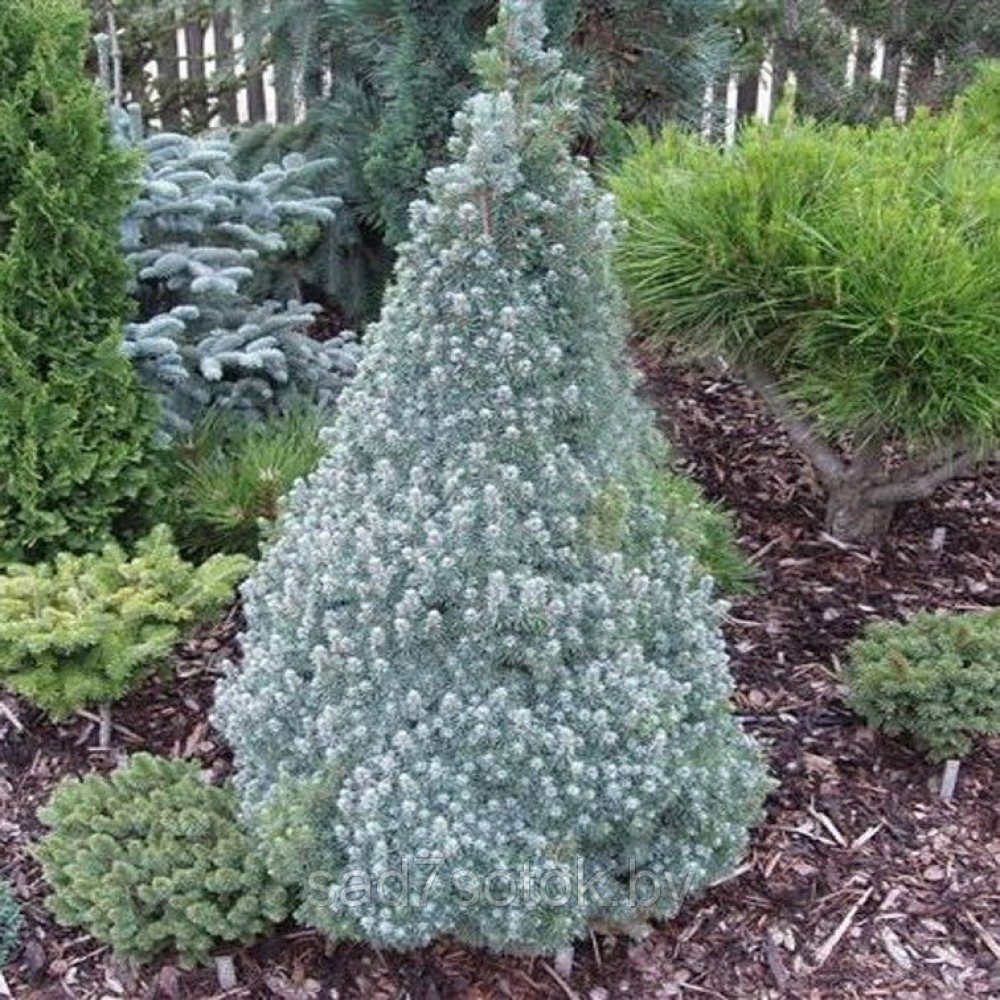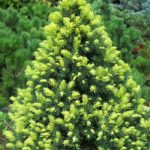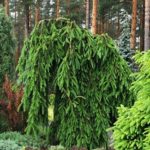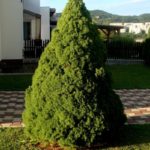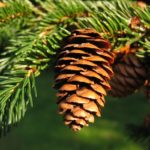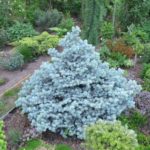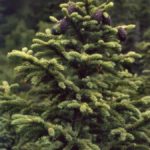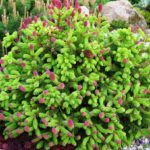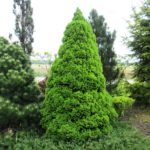Dwarf blue spruce is a small copy of taller plants. It takes up minimal space on the site and at the same time harmoniously complements the exterior at any time of the year. In summer the plant goes well with flowers, and in winter it contrasts with white snow. The popularity of the culture is associated with the unusual color of the needles and high frost resistance. In order for the plant to look decorative, it is important to provide it with quality care.
- Description of the species
- Popular varieties
- Argentea Pendula (Argentea Pendula)
- Blaukissen (Blue Kiss)
- Blue Trinket
- Frieda (Frida)
- Echiniformis (Echinoformis)
- Edith (Edith)
- GlaucaGlobosa (Glauca Globosa)
- Glauca Pendula (Glauca Pendula)
- Hermann Naue
- Montgomery
- Niemetz (German)
- Nidiformis Kalous (Nidiformis Kalous)
- Waldbrunn
- Ruby Teardrops
- Sanders Blue
Description of the species
Blue spruces belong to the genus Picea. In addition to them, this group includes another 35 plant species. Blue spruce trees are characterized by needles that are fixed on the branches with a slightly thickened part. The needles themselves are very densely arranged. This is the main difference between blue spruces and other representatives of the genus.
In addition to blue, Picea pungens is also called white, prickly, and silver. The bluish color of the needles is associated with the presence of a waxy coating on the needles. In some varieties it is due to the fact that the stomata of the needles are lighter in color compared to the rest.
Dwarf varieties of blue spruce were identified in 1862. Currently, several hundred low-growing varieties have been bred. Globoza is considered the most common. Also popular varieties include Glauka Globoza And Montgomery. They have similar growth habits and colors.
Popular varieties
Today there are quite a few varieties of blue spruce, each of which has certain characteristics.
Argentea Pendula (Argentea Pendula)
This variety is characterized by a conical crown shape. At the same time, its branches densely cover the trunk, and the lower tiers bend towards the ground. This is a fairly small spruce. By the age of 10, its height does not exceed 1.5-2 meters. The width of the plant is approximately 1 meter. Over the course of a year, the tree grows a maximum of 15-30 centimeters.
Spruce needles of this variety reach a length of 4 centimeters. It is characterized by elongated cones that are directed vertically upward.They change their color - from violet-red to brown. To plant such a crop, you need to choose a sunny area that is protected from the wind. Spruce easily tolerates frost and the effects of polluted air. However, it cannot be planted in clay soil.
Blaukissen (Blue Kiss)
The name of this variety is due to the appearance of the plant. Over the course of a year, this crop grows by a maximum of 3.5 centimeters. By the age of 10, the plant reaches a height of no more than 45 centimeters. It can be used to design rocky gardens. The plant needs to be planted in soil that contains many nutrients. The site must have high-quality lighting and good drainage.
The size of the plant's needles is 2-3 centimeters. They are distinguished by their gray-blue color and quadrangular shape. The plant is also characterized by brown cones.
Blue Trinket
Spruce variety Blue Trinket is a compact blue spruce that has a conical crown and moderate growth. After 10 years, the plant reaches a height of 2 meters. The maximum possible size is 6 meters. Over the course of a year, the crop grows by 5-8 centimeters. A distinctive feature of the variety is a high degree of resistance to low temperatures.
Spruce needs to be planted in the ground with a lump of earth. It grows well in a sunny area. At the same time, the crop needs fertile and moist soil that has high-quality drainage. The plant can also develop well in poorer soil. Blue Trinket is considered an excellent option for medium and large areas. The tree will be a wonderful accent to a bright floral arrangement.
Frieda (Frida)
This variety is considered very low growing.Spruce is characterized by an extremely slow growth rate, which does not exceed 2-5 centimeters per year. By the age of 10, the size of the culture is 40x25 centimeters. Its needles look very attractive. It is covered with a steely wax coating. In this case, the color of the needles varies from blue-green to gray-blue.
The plant is distinguished by a dense, compact crown that resembles a nest or has an irregular round shape. It consists of horizontal short branches. It is recommended to grow the Frida variety in well-lit areas. The culture is resistant to frost. At the same time, it is not too demanding on the composition of the soil and its moisture content. However, it is important to avoid over-watering the plantings.
Echiniformis (Echinoformis)
This is a small blue spruce that has a dense crown in the shape of a hemisphere. If you do not prune the plant, with age it will grow in different directions and take on a cushion shape. By grafting onto a low stem, it is possible to obtain a ball of the correct shape. Even by the age of 30, the spruce does not exceed 60 centimeters in height. In this case, the crown has a diameter of 1 meter.
Echinoformis spruce is characterized by short shoots that grow radially from the central part of the bush. The culture also has narrow bluish-green needles 5-7 millimeters long and the absence of cones. When growing, the nutritional properties and lightness of the soil are of great importance. Also, do not over-moisten the soil. However, in general, Echinoformis is an undemanding crop.
Edith (Edith)
This low-growing variety has a perfect conical crown. It has a high degree of density due to thin needles that grow densely on the branches.In the first years, blue spruce has a leading shoot, which over time becomes the basis for the development of a correct, even crown. By the age of 10, the spruce reaches a height of 1.5-2 meters. Further annual growth is 20-25 centimeters.
The plant is characterized by small cones measuring 3-6 centimeters, which appear on trees aged 6-8 years. In spring they are pink in color, but gradually acquire a light brown tint. The Edith variety is considered resistant to frost and drought. It can withstand air pollution normally. Even a little partial shade is suitable for growing the crop. However, in a sunny area the crown turns out to be more lush and acquires an attractive blue color.
GlaucaGlobosa (Glauca Globosa)
This is a very common low growing blue spruce. The tree is characterized by a crown in the form of a ball or cone. It can also be asymmetrical. Moreover, in young trees the crown more closely resembles a loose ball. Only in mature plants does a leading shoot appear, which is characterized by more active development. It represents the base for a more elongated crown. Systematic trimming also allows you to maintain the shape of the ball.
Glauca Globosa has a slow growth rate. By the age of 10, the plant reaches 1 meter. However, it does not exceed 2-3 meters in height. The plant is characterized by rather hard needles of a silver-blue hue. At the same time, the young shoots are decorated with pale blue needles.
The male cones of the plant are characterized by a brownish-brown hue. In this case, female fruits are initially red and then become greenish. They may also have a light brown tint. Trees of this variety can easily withstand air pollution.This makes it possible to plant them in city parks.
Glauca Pendula (Glauca Pendula)
This is a very unusual spruce, which is distinguished by a weeping crown. The dense placement of hanging branches creates a cascading effect. In this case, the lower shoots practically lie on the ground.
The tree essentially has no trunk. However, its functions can be performed by a strong shoot, which is tied to a support. The plant is distinguished by dense blue needles, which retain their rich color throughout the season. However, when growing the crop in open areas, it is possible to achieve a brighter color.
The height of the tree can be adjusted by tying and grafting. This helps to achieve different shapes and dimensions. In small areas, the maximum tree height should be 3-5 meters. If the spruce is not tied and a low graft is made, the crop can be grown as a ground cover plant. The variety is characterized by resistance to smoke and soot. In addition, it can withstand dry weather well.
Hermann Naue
Spruce trees of this variety are characterized by a dense, thorny crown. It has a pillow-shaped shape. As the tree ages, it becomes more cone-like. By the age of 10 years, the plant usually reaches a height of 70 centimeters. Its diameter is 80-90 centimeters. Spruce trees of this variety do not have a central trunk. Moreover, they have short, stiff branches with gray-blue needles.
During fruiting, the tree is covered with many cones of a rich pink hue. As they dry, they acquire a light brown tint. This plant withstands summer drought and frost well.
Montgomery
This crop has a slow growth rate. Over the course of a year, it grows by a maximum of 5-6 centimeters. An adult spruce can reach 2-3 meters. Moreover, its diameter is 2 meters. The plant has silver-blue needles up to 20 millimeters in size. As it ages, it turns bright blue.
Young crops have a spherical crown. With age, it lengthens, turning into a wide cone. Sometimes several crowns form on a tree. To obtain a dense crown of the required shape, it is worthwhile to carry out regular pruning. It is recommended to do this before mid-summer.
Niemetz (German)
This is a very attractive plant that has a cone-shaped crown. The culture has an average growth rate. By the age of 10, it reaches a height of 1 meter. In this case, the girth of the tree is 70-80 centimeters.
The needles, which appear in early spring, are creamy-yellow in color. After a few weeks it becomes bluish-silver and thickens. Female cones have a red tint. After ripening they turn green and turn brown. In order for the cultivation of spruce of this variety to be successful, it must be planted in a well-lit place. Good drainage and frequent irrigation are important.
Nidiformis Kalous (Nidiformis Kalous)
This dwarf blue spruce was developed in the Czech Republic. The shape of its crown resembles a flattened cube or ball. The plant is characterized by short branches. The needles grow in length up to 2-3 centimeters. After 10 years, the culture grows to 50-70 centimeters. The width of the plant is 80 centimeters.In 1 year, the crop grows by a maximum of 5-10 centimeters.
Waldbrunn
This plant is characterized by rather slow development. Moreover, its height does not exceed 80 centimeters. The culture is characterized by a round, spreading crown, in the center of which there is a depression. As it grows, it disappears, and the crown takes on a cone-shaped shape. To achieve greater symmetry, the central shoot must be tied to a support.
Short branches are characterized by horizontal development and a high degree of density. Young needles have a rich blue hue, but over time they acquire a silvery-gray color. At the same time, the tree is distinguished by soft needles up to 1.5 centimeters in size.
Ruby Teardrops
This dwarf variety gets its unusual name due to the presence of bright red cones that contrast with the rich blue needles. They retain their color for 2 months, after which they turn greenish and then brown.
The annual growth of branches reaches 5-10 centimeters. By the age of 10, the crop grows to 1 meter. Moreover, its diameter is 1.5 meters. The variety is considered very unpretentious. In addition, it is resistant to frost. However, the tree does not tolerate stagnant moisture and high soil density.
Sanders Blue
This culture is often used in landscape design. This is due to the presence of a conical crown. In 1 year, the plant grows by a maximum of 5-7 centimeters. By the age of 10, the height of the crop is 70-100 centimeters. Immediately after emergence, the needles have a pale blue tint, but by July they turn green. Thanks to this, the trees acquire an interesting spotted color. More details on link.
Dwarf blue spruces are very attractive plants that are often used in landscape design. For the cultivation of such crops to be successful, it is important to provide them with proper care.


